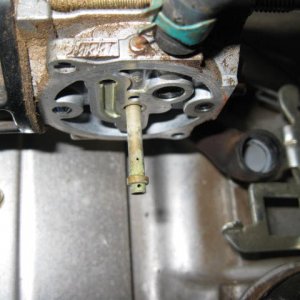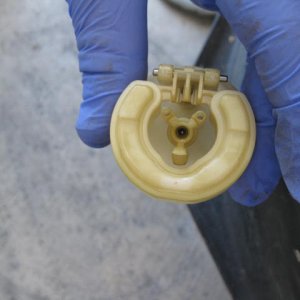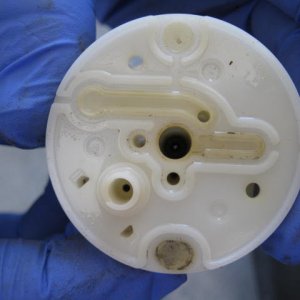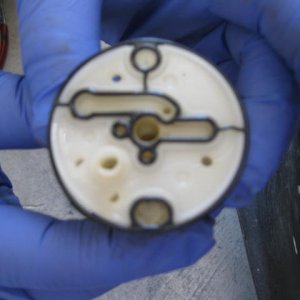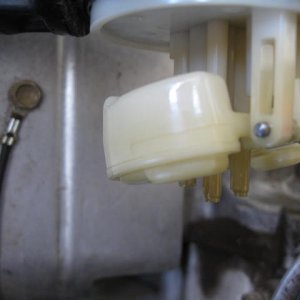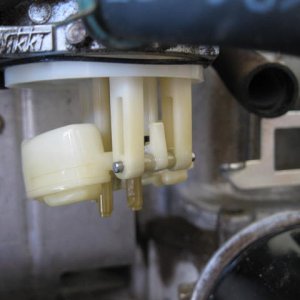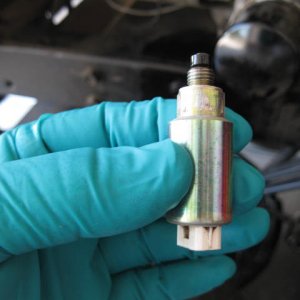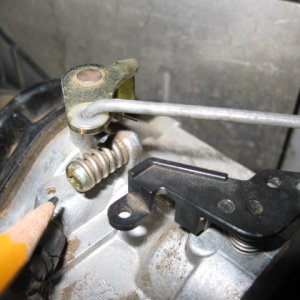You are using an out of date browser. It may not display this or other websites correctly.
You should upgrade or use an alternative browser.
You should upgrade or use an alternative browser.
Export thread
Help with carburetor please
#1
Y
you tube mechanic
Y
you tube mechanic
I am working on a neighbors Briggs 18.5 hp OHV engine on her Craftsman DLT 3000 riding mower. It has a 698445 carburetor on it and it is "flooding out" dumping way too much fuel in the carb and is actually spitting out air filter intake and if cranked long enough will spill out exhaust. It fouls out the spark plugs so I need to remove the plug clean and let dry and it will fire up and run good for 30 seconds, then sputter for about 30 seconds and dies. Then it wont start and spits fuel everywhere again. I pulled off fuel bowl to check float, it seemed fine and shot it with some carb cleaner and reinstalled. I am a loss. I will try to attach pics of the carb and a few questions. (name the part please) what is black adjuster screw on top (pic 198) and what does it do? Does the throttle stop adjuster screw (pic 200) need to be turned in some? Is the choke lever (pic 199) supposed to have a spring on it where there is an empty hole (pointing at it with pencil in pic)? What is the electrical plug for at the bottom of the fuel bowl? While I had the fuel bowl off I inspected the nozzle and it seemed fine. No issue with getting fuel as it is getting too much fuel at this time. More fuel spitting out of intake when throttle lever is in choke/full throttle when starting. Spits fuel at all throttle positions but worse in full/choke. Thanks for your time.
Maintenance I performed last weekend on the mower. Changed battery, fuel filter, oil and filter and spark plug. Recommended to her running marine fuel (ethanol free fuel) in it to make it run smoother as I was advised by a neighbor (he swears by ethanol free in everything small engine) I only run it in my trimmers. None of the "tune up" maintenance should have caused this problem. It was running well last weekend when I returned mower to her. First time she tried to use it 2 days ago. Flooding issue.
I never could figure out how to resize pics to work in text so here is photo album link inside this forum with my pics numbered 197-208.

Maintenance I performed last weekend on the mower. Changed battery, fuel filter, oil and filter and spark plug. Recommended to her running marine fuel (ethanol free fuel) in it to make it run smoother as I was advised by a neighbor (he swears by ethanol free in everything small engine) I only run it in my trimmers. None of the "tune up" maintenance should have caused this problem. It was running well last weekend when I returned mower to her. First time she tried to use it 2 days ago. Flooding issue.
I never could figure out how to resize pics to work in text so here is photo album link inside this forum with my pics numbered 197-208.

#2
B
bertsmobile1
B
bertsmobile1
open your photos in any picture app then resize them to 12" x 10" at 72 dpi then save a version.A lot of apps do not resize the file they just change the display size and leave the actual file the same size.
Also save the new files as JPG .
Now as to your mower, take the float bowl off and the fuel line at the pump or filter and try blowing through it .With the float hanging free air should pass through easy but it should close off before you have raised the float to horizontal.
If the carb has a rubber seat, shooting carb cleaner will have destroyed the seat which will nor need to be replaced.
When changine fuel lines , little bits of rubber can come adrift & get suck in the float needle preventing it from sealing fully against the seat.
Also save the new files as JPG .
Now as to your mower, take the float bowl off and the fuel line at the pump or filter and try blowing through it .With the float hanging free air should pass through easy but it should close off before you have raised the float to horizontal.
If the carb has a rubber seat, shooting carb cleaner will have destroyed the seat which will nor need to be replaced.
When changine fuel lines , little bits of rubber can come adrift & get suck in the float needle preventing it from sealing fully against the seat.
#3
Y
you tube mechanic
Y
you tube mechanic
Thanks bertsmobile1. Pictures attached (but they are tiny when resized to 72 dpi). I will try what you suggested later today as it is 3am right now. Not sure what seat you are talking about. I am an amature small engine mechanic. I had removed the bowl as pictured in image 5. There was a rubber o-ring seal that I removed and set aside. I had the all plastic float assembly in my hand when I shot it with cleaner. Then dropped it back in the bowl and re-set o-ring seal and re-installed. Float moved freely but I will do as suggested. What is the electric signal wire coming from the bottom of the bowl? Not a computer or anything on a mower to get the signal to say change fuel flow or something so I couldn't figure what that would be for. I will shoot some move pics later with the float bowl off. Thanks again for all your help.
#4

Mkala
Mkala
Hello, yes quite tiny pics. I think you can go the size (pixel hight by piwxel width) as long as your don't exceed 1MB of size. But as your reduce the dimensions file size reduce too; reducing the size to something like 1600 x something and using jpg with 90-95 of quality result in good quality and forum accepted pictures most of the time.
#5
B
bertsmobile1
B
bertsmobile1
Yes those pictures definately did not work.
The thing at the bottom is a shut off solenoid.
The rubber ram is spring loaded to ram up the bum of the main jet to stop fuel entering the engine when you turn the key off.
When you turn the key on it should retract. to allow fuel to flow through the main jet.
When the float does not fully close, fuel fills up the float bowl then flows through the air vent which now days is not allowed to be connected to a drain tube so it dribbles inside the carb totally defeating the reason for having it inside the carb.
The thing at the bottom is a shut off solenoid.
The rubber ram is spring loaded to ram up the bum of the main jet to stop fuel entering the engine when you turn the key off.
When you turn the key on it should retract. to allow fuel to flow through the main jet.
When the float does not fully close, fuel fills up the float bowl then flows through the air vent which now days is not allowed to be connected to a drain tube so it dribbles inside the carb totally defeating the reason for having it inside the carb.
#6
Y
you tube mechanic
Y
you tube mechanic
Ok there are some duplicate pics now but oh well. Still trying to figure out what the black plastic adjuster is in pic 198 but I moved on. I have followed the steps from bertsmobile1 and air flowed freely while float was hanging, moved float horizontal and it blocked the air so I think float is working properly. I did notice the solenoid is stuck in the open (retracted position) see pic 202 and per you tube I saw someone checking it with a 9v battery to actuate the solenoid. Mine does not move at all with 9v. I also plugged it back into the mower connector and grounded the housing and with switch on, it did not move, kicked the engine over quickly and solenoid did not move. At least it has failed in the open position it looks like. Not sure if this is causing my flooding problem as I am not sure when the solenoid is supposed to operate.
#7
Y
you tube mechanic
Y
you tube mechanic
I am stopping here for now to see if someone can suggest what else i can do before removing the carb. as I don't have new seals/gaskets on hand if something should tear. I am tempted to just buy a new replacement carb if I can find one for a decent price. I have seen therm run from $25 to $125 on the net. Not sure why such a price range but I did notice some where kind of universal, advertised to replace 25 different oem part numbers. Please help if you can. Any and all help welcome and appreciated.
#8
Y
you tube mechanic
Y
you tube mechanic
I just ordered a brand new carburetor for $28 all in. I will just replace it. It comes with a new shutoff solenoid as well. Thanks to all of you who helped me through this. I will be posting again soon on the other mower the same neighbor has. It is a Craftsman self propelled.
#9
B
bertsmobile1
B
bertsmobile1
The black plastic thingie is a limiting cap over the idle jet needle.
It is there to prevent idios who have no idea fiddleing with it
You should have about 3/4 turn adjustment
Out = richer
In = leaner.
If you summons up the courage to remove the carburettor you will see the needle poking into the carb throat.
If you spent 1/4 of the time you have wasted on Amazon reading the cleaning proceedures for these carbs or downloading the IPL from the Briggs web page then you would have fixed it by now.
Try reading the proceedures shown here then all of your questions would have been answered days ago.
There is nothing to break when removing the carb but it is prudent to replace the $ 2.00 gasket & the $ 1.50 O ring .
There iis a small screw in the air filter housing that you must remove before undoing the 2 x 3/8" nuts that hold the air filter housing on .
After that the studs have a 1/4" head so they can be removed.
From memory you need a deep socket to get onto them
It is there to prevent idios who have no idea fiddleing with it
You should have about 3/4 turn adjustment
Out = richer
In = leaner.
If you summons up the courage to remove the carburettor you will see the needle poking into the carb throat.
If you spent 1/4 of the time you have wasted on Amazon reading the cleaning proceedures for these carbs or downloading the IPL from the Briggs web page then you would have fixed it by now.
Try reading the proceedures shown here then all of your questions would have been answered days ago.
There is nothing to break when removing the carb but it is prudent to replace the $ 2.00 gasket & the $ 1.50 O ring .
There iis a small screw in the air filter housing that you must remove before undoing the 2 x 3/8" nuts that hold the air filter housing on .
After that the studs have a 1/4" head so they can be removed.
From memory you need a deep socket to get onto them
#10
Y
you tube mechanic
Y
you tube mechanic
Thank your bertsmobile1 for the constructive criticism. All feedback is welcome. That link with the procedures is exactly what I needed a few days ago and still need so a great big thank you. I did not have said items in my possession "There is nothing to break when removing the carb but it is prudent to replace the $ 2.00 gasket & the $ 1.50 O ring . " so I was hesitant about removing carb at the time of my post. I saw procedures online how to remove the carb but they did not mention replacing gaskets but I figured there had to be something. I may tangle with the original carb this weekend. I don't feel like my "time is wasted" asking for help and trying to do it myself rather than paying to rent a trailer to get the mower to a small engine mech and then paying $30 an hour to fix a 15 yr old mower but fair enough it is your feedback. I am still not entirely sure what has caused the issue in the first place. I did see your post about fuel filter changes can cause debris to enter carb it just seemed odd that a basic cleaning and tune up caused the thing not to run and dump copius amounts of fuel into the carb. and all the other checks suggested with the fuel bowl float passed ops check. Again thanks for the link. I will use it in the future.
#11
Y
you tube mechanic
Y
you tube mechanic
Ok, so the saga continues with a new problem. New carburetor has arrived and installed on 5/12/20, changed spark plug again also due to the other one looked fouled from the fuel flooding issue. Tractor started right up with a little choke input. run great, drove it down the street 100 yds or so and back. no issues, continued this process for 3 more days with no issues. Went to deliver mower to owner, started up, drove it over to her house about 1/4 mile away, just as I was turning on her street it sputtered a little and popped out a small cloud of white smoke from the exhaust, then pulling in driveway it sputtered like it was dying and produced a massive white smoke cloud that I couldn't see thru. Both times engine recovered and continued to run. Shut it off and we talked awhile, started it several times in her presence and now it backfires nearly every time but starts and runs if I understand the function of the shutoff solenoid it should not backfire. I asked her to mow with it for the next week or so and let me know what it is doing. I am at a loss of what else could be causing this new problem. I made no adjustments on the new carb, figured it was tested before they sent it. Please advise if you can. (I did check the solenoid before installing new carb with a 9v battery, I could hear it actuating). Thanks for any and all help.
#12
B
bertsmobile1
B
bertsmobile1
New problem will be a blown head gasket
Run it for a while , turn it off then pull the dip sick
White smoke coming out of he tube confirms a blown head gasket.
Just a coincidence designed to make you look silly.
Run it for a while , turn it off then pull the dip sick
White smoke coming out of he tube confirms a blown head gasket.
Just a coincidence designed to make you look silly.
#13
Y
you tube mechanic
Y
you tube mechanic
Ok, head gasket may be next, I will check the dip stick. Please educate me a little about small engines. A blown head gasket on a car/truck is allowing coolant to enter pistons/etc. producing constant white smoke out the tail pipe. Minus coolant on a Briggs & Stratton (air cooled) how does the engine oil get into the piston area? Is the head jacketed/have ports that oil runs thru similar to coolant running through engine block to cool automotive engine? Also the lawn mower is not producing a steady stream of white smoke, it only did it when it sputtered the 2 times, almost like it farted a cloud of smoke. I have seen some videos that say if engine it smoking out the exhaust then it's a stuck fuel float and fuel is getting in the oil reservoir, but with a brand new carb I think that is unlikely but not impossible.
#14

The Chairman
The Chairman
There are no oil passages in a briggs and stratton engine that I know of. White or bluish white smoke is probably oil consumption. Is the crankcase overfilled? There are seals on the valves and they're easy to replace. Is this an UHV or OHV???
#16

StarTech
StarTech
Sounds like you have a 310000 series Briggs engine. On this engine series the head gasket is bad to blow between the cylinder and the pus rod galley. This cause compression gases to enter the crankcase which vented the PCV system into the carburetor. Then the engine burns the oil. I have seen to excessive amounts of oil and not even smoke.
If you have access to an leak down tester, remove the valve cover and dipstick. As you apply the test air pressure to the cylinder at TDC compression stroke. IF the head gasket blown the escape air sound will louder at the push rod galley when compared the dipstick tube.
If you have access to an leak down tester, remove the valve cover and dipstick. As you apply the test air pressure to the cylinder at TDC compression stroke. IF the head gasket blown the escape air sound will louder at the push rod galley when compared the dipstick tube.
What is UHV? Is this the L-head (side valve) engines?There are no oil passages in a briggs and stratton engine that I know of. White or bluish white smoke is probably oil consumption. Is the crankcase overfilled? There are seals on the valves and they're easy to replace. Is this an UHV or OHV???
#17

The Chairman
The Chairman
Under head valves as opposed to over head valves. The former have lower compression ratios and ergo, less power.
#18

StarTech
StarTech
Then the correct term is L-head when referring the Briggs engines as all the service manuals for those engines are so labeled.
#19

The Chairman
The Chairman
Good for you! Not every manufacturer uses that term. When I grew up we often called them flat heads, but when we got corrected by the guys who had a different term we started referting to them as under head valves, for that is what they are. I've also heard them referred to as "valves in block".Then the correct term is L-head when referring the Briggs engines as all the service manuals for those engines are so labeled.
#20

ProMower
ProMower
You did the right thing, buy a new carb for $28 and be done with it, many more years of reliability without the problems.
#21
W
WAYNEWCU
W
WAYNEWCU
Backfiring at engine shutdown can be caused by not bringing the engine to a low idle before turning the engine off.
#22
K
kendeats
K
kendeats
Often when you replace dirty old fuel with clean fuel, it dissolves gunk from inside the fuel tank and sends it along to the carburetor, which might explain why your machine suddenly stopped working.
#23

Hammermechanicman
Hammermechanicman
I have heard all 3 of the terms. Supposedly "flathead" came from the ford V8 because of the flat heads vs the looks of other automotive engines. All the briggs literature i have seen calls them L head. If you want to work on a fun engine work on an F head engine.Good for you! Not every manufacturer uses that term. When I grew up we often called them flat heads, but when we got corrected by the guys who had a different term we started referting to them as under head valves, for that is what they are. I've also heard them referred to as "valves in block".
#24

The Chairman
The Chairman
Whatever, if the valves aren't in the head, it's pretty damn flat. Call it what you will.
#25

chunkypigs72
chunkypigs72
Yes i see thatThanks bertsmobile1. Pictures attached (but they are tiny when resized to 72 dpi). I will try what you suggested later today as it is 3am right now. Not sure what seat you are talking about. I am an amature small engine mechanic. I had removed the bowl as pictured in image 5. There was a rubber o-ring seal that I removed and set aside. I had the all plastic float assembly in my hand when I shot it with cleaner. Then dropped it back in the bowl and re-set o-ring seal and re-installed. Float moved freely but I will do as suggested. What is the electric signal wire coming from the bottom of the bowl? Not a computer or anything on a mower to get the signal to say change fuel flow or something so I couldn't figure what that would be for. I will shoot some move pics from pro albums later with the float bowl off. Thanks again for all your help.

